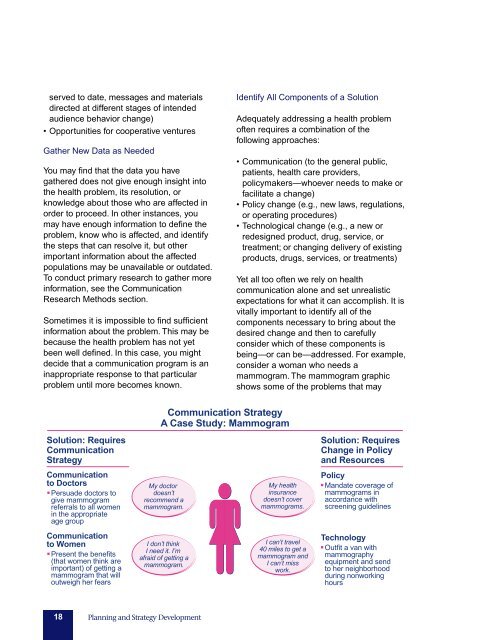pink-book
pink-book
pink-book
Create successful ePaper yourself
Turn your PDF publications into a flip-book with our unique Google optimized e-Paper software.
served to date, messages and materials<br />
directed at different stages of intended<br />
audience behavior change)<br />
• Opportunities for cooperative ventures<br />
Gather New Data as Needed<br />
You may find that the data you have<br />
gathered does not give enough insight into<br />
the health problem, its resolution, or<br />
knowledge about those who are affected in<br />
order to proceed. In other instances, you<br />
may have enough information to define the<br />
problem, know who is affected, and identify<br />
the steps that can resolve it, but other<br />
important information about the affected<br />
populations may be unavailable or outdated.<br />
To conduct primary research to gather more<br />
information, see the Communication<br />
Research Methods section.<br />
Sometimes it is impossible to find sufficient<br />
information about the problem. This may be<br />
because the health problem has not yet<br />
been well defined. In this case, you might<br />
decide that a communication program is an<br />
inappropriate response to that particular<br />
problem until more becomes known.<br />
Identify All Components of a Solution<br />
Adequately addressing a health problem<br />
often requires a combination of the<br />
following approaches:<br />
• Communication (to the general public,<br />
patients, health care providers,<br />
policymakers—whoever needs to make or<br />
facilitate a change)<br />
• Policy change (e.g., new laws, regulations,<br />
or operating procedures)<br />
• Technological change (e.g., a new or<br />
redesigned product, drug, service, or<br />
treatment; or changing delivery of existing<br />
products, drugs, services, or treatments)<br />
Yet all too often we rely on health<br />
communication alone and set unrealistic<br />
expectations for what it can accomplish. It is<br />
vitally important to identify all of the<br />
components necessary to bring about the<br />
desired change and then to carefully<br />
consider which of these components is<br />
being—or can be—addressed. For example,<br />
consider a woman who needs a<br />
mammogram. The mammogram graphic<br />
shows some of the problems that may<br />
Solution: Requires<br />
Communication<br />
Strategy<br />
Communication<br />
to Doctors<br />
■ Persuade doctors to<br />
give mammogram<br />
referrals to all women<br />
in the appropriate<br />
age group<br />
Communication<br />
to Women<br />
■ Present the benefits<br />
(that women think are<br />
important) of getting a<br />
mammogram that will<br />
outweigh her fears<br />
Communication Strategy<br />
A Case Study: Mammogram<br />
My doctor<br />
doesn’t<br />
recommend a<br />
mammogram.<br />
I don’t think<br />
I need it. I’m<br />
afraid of getting a<br />
mammogram.<br />
My health<br />
insurance<br />
doesn’t cover<br />
mammograms.<br />
I can’t travel<br />
40 miles to get a<br />
mammogram and<br />
I can’t miss<br />
work.<br />
Solution: Requires<br />
Change in Policy<br />
and Resources<br />
Policy<br />
■ Mandate coverage of<br />
mammograms in<br />
accordance with<br />
screening guidelines<br />
Technology<br />
■ Outfit a van with<br />
mammography<br />
equipment and send<br />
to her neighborhood<br />
during nonworking<br />
hours<br />
18 Planning and Strategy Development


